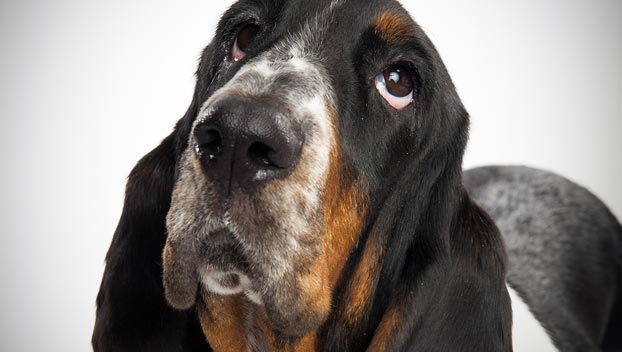Basset Hound
The basset's long, heavy body and short legs make it easy to follow on foot and give it an edge in dense cover. The basset hound has heavier bone, in proportion to its total size, than any other breed. Its thick, tight coat protects it from brambles without becoming caught in them. It is speculated that its long ears may stir up ground scent, and the wrinkles trap the scent around the face. The large muzzle gives ample room for the olfactory apparatus. Such room would not be available in a miniature dog; only a large dog with shortened legs can combine the short height with large muzzle size. The basset's movement is smooth and powerful; it tends to move with nose to the ground.
The basset hound is among the most good-natured and easygoing of breeds. It is amiable with dogs, other pets and children, although children must be cautioned not to put strain on its back with their games. It is calm inside, but it needs regular exercise to keep fit. It prefers to investigate slowly, and loves to sniff and trail. It is a talented and determined tracker, not easily dissuaded from its course. Because of this, it may get on a trail and follow it until it becomes lost. It tends to be stubborn and slow-moving. It has a loud bay that it uses when excited on the trail.
The first mention of the basset dog is found in a 16th-century text about badger hunting. Dwarfed short-legged specimens occur in many breeds and have been known since ancient times, but it is difficult to know at what point such dogs were purposefully bred and which ones led to the present basset hound. The word basset is derived from the French word bas, which means "low thing or dwarf," so that definitive evidence of the breed may be hard to follow. Short-legged dogs were used by the French for hunting at a slower pace, but most of these dogs were dispersed, and their fates undocumented, during the French Revolution. The history becomes clearer after the revolution, when greater numbers of commoners took up hunting, often aided by guns. They needed a dog that they could follow on foot, but that still had great scenting ability and strong, heavy bone — in essence, a short-legged version of the pack hounds popular with the aristocracy. Because the basset could not pursue its quarry at speed, the quarry was less likely to be on the run and thus presented an easier target for the gunman. The dogs would hunt all mammals but were especially suited for rabbits and hares. Four different versions of short-legged hounds were created, with the basset Artesien Normand most closely resembling today's basset. In the late 1800s (and again in 1930), crosses with bloodhounds were made to increase size; the results were then tempered with subsequent crosses to the Artesien Normand. The first bassets were brought to England and America in the late 1800s, and interest in the breed grew gradually. By the mid-1900s, the basset's droll expression had won it a place in advertising and entertainment and in many new pet owners' hearts.
 Login
Login






